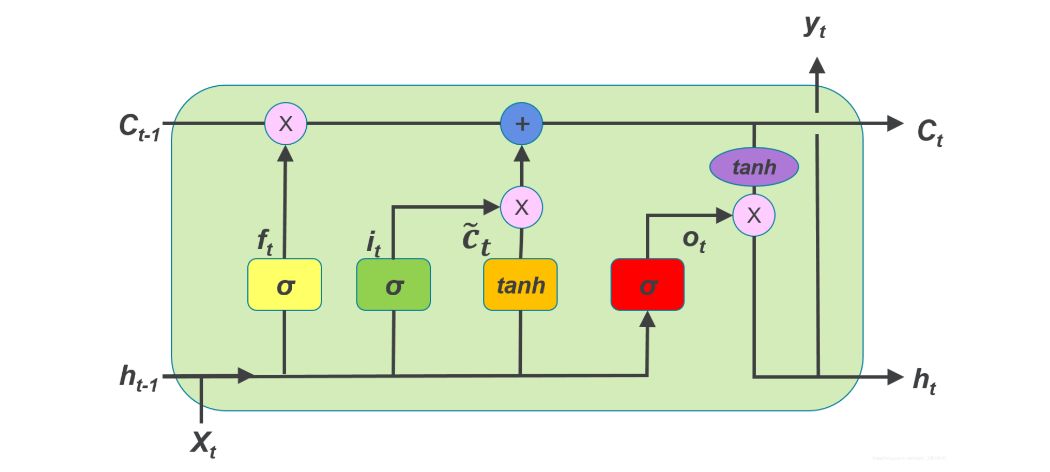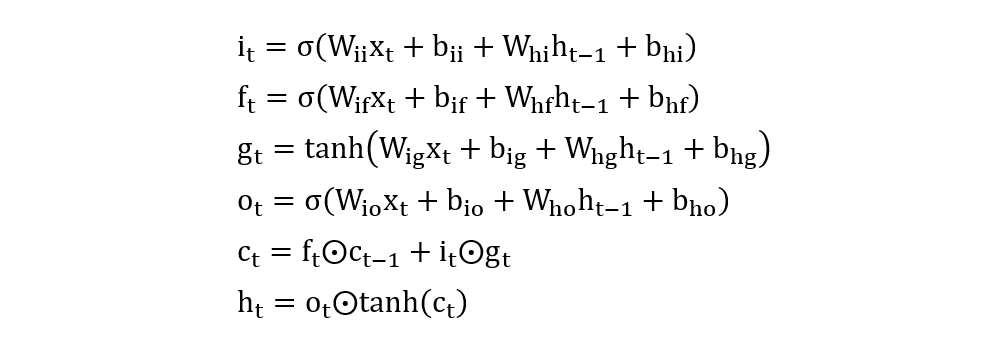长短期记忆网络(Long Short-Term Memory,LSTM)是一种特殊的循环神经网络(RNN),与传统的 RNN 相比,在处理涉及较长距离时间依赖的任务中表现出更强的能力。
1. 算法原理
LSTM 为了解决传统 RNN 面临的长期依赖问题,引入了细胞状态(Cell State)、门控单元(Gate)实现长期信息的记忆。
- 细胞状态:用来携带长期信息的主要通道
- 门控单元:用于控制信息的流动
- 输入门:控制当前输入信息有多少信息被写入细胞状态
- 遗忘门:控制前一时刻的细胞状态有多少信息被保留到当前时刻
- 输出门:控制当前细胞状态的多少信息输出作为隐藏状态传递到下一时刻

- \(h_{t-1}\)表示上一个时间步的隐藏状态
- \(h_{t}\) 表示当前时间步的隐藏状态
- \(X_{t}\) 表示当前时间步的输入
- \(C_{t-1}\) 表示上一个时间步记忆的长期依赖信息
- \(C_{t}\) 表示当前时间步记忆的长期依赖信息
- \(\sigma\) 表示 sigmoid 激活函数
- \(tanh\) 表示 tanh 激活函数
- \(g_{t}\) 表示当前输入的信息(正:积极信息,负:负面信息)
- \(f_{t}\) 表示遗忘门,保留多少细胞信息
- \(i_{t}\) 表示输入门,保留多少输入信息到细胞状态
- \(o_{t}\) 表示输出门,输出多少细胞信息
我们针对上图的理解:
- 细胞状态会累积序列中所有的元素的信息
- 通过门控机制来控制历史信息、输入的信息、输出信息保留多少
相关的计算公式如下:

2. 算法使用
import torch
import torch.nn as nn
def test01():
torch.manual_seed(42)
lstm = nn.LSTM(input_size=2, hidden_size=4, num_layers=1, bidirectional=False)
# 1. 重要:输入形状(seq_len, batch_size, dim)
inputs = torch.randn(3, 1, 2)
# 初始化细胞状态、隐藏状态(可省略)
# 形状:(num_layers * num_directions, batch_size, hidden_size)
h_0 = torch.zeros(1, 1, 4)
c_0 = torch.zeros(1, 1, 4)
# 2. 重要:输入参数和输出结果
# output: 每个元素对应的隐藏状态
# hn:最后一个元素的隐藏状态
# cn:最后一个元素的细胞状态
output, (hn, cn) = lstm(inputs, (h_0, c_0))
print('output shape:', output.shape)
print('hn shape:', hn.shape)
print('cn shape:', cn.shape)
print(output)
print(hn)
print(cn)
def test02():
torch.manual_seed(42)
lstm = nn.LSTMCell(input_size=2, hidden_size=4)
inputs = torch.randn(3, 1, 2)
# 初始化细胞状态、隐藏状态
hx = torch.zeros(1, 4)
cx = torch.zeros(1, 4)
# 计算每一个时间步
for idx in range(inputs.shape[0]):
hx, cx = lstm(inputs[idx], (hx, cx))
print(hx)
print(cx)
if __name__ == '__main__':
test01()
print('-' * 70)
test02()
程序输出结果:
output shape: torch.Size([3, 1, 4])
hn shape: torch.Size([1, 1, 4])
cn shape: torch.Size([1, 1, 4])
tensor([[[-0.0382, -0.0373, -0.0662, -0.0236]],
[[-0.1445, -0.0549, -0.0175, -0.0920]],
[[-0.0706, -0.0701, -0.0888, -0.1205]]],
grad_fn=<MkldnnRnnLayerBackward0>)
tensor([[[-0.0706, -0.0701, -0.0888, -0.1205]]], grad_fn=<StackBackward0>)
tensor([[[-0.1892, -0.1798, -0.1382, -0.2783]]], grad_fn=<StackBackward0>)
----------------------------------------------------------------------
tensor([[-0.0706, -0.0701, -0.0888, -0.1205]], grad_fn=<MulBackward0>)
tensor([[-0.1892, -0.1798, -0.1382, -0.2783]], grad_fn=<AddBackward0>)

 冀公网安备13050302001966号
冀公网安备13050302001966号